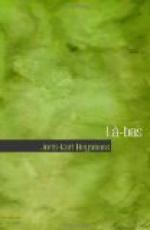“And the interior of the edifice is not more religious nor artistic than the exterior. The only thing in it that pleases me is good Carhaix’s aerial cave.” Then he looked about him. “This square is very ugly, but how provincial and homelike it is! Surely nothing could equal the hideousness of that seminary, which exhales the rancid, frozen odour of a hospital. The fountain with its polygonal basins, its saucepan urns, its lion-headed spouts, its niches with prelates in them, is no masterpiece. Neither is the city hall, whose administrative style is a cinder in the eye. But on this square, as in the neighbouring streets, Servandoni, Garanciere, and Ferrou, one respires an atmosphere compounded of benign silence and mild humidity. You think of a clothes-press that hasn’t been open for years, and, somehow, of incense. This square is in perfect harmony with the houses in the decayed streets around here, with the shops where religious paraphernalia are sold, the image and ciborium factories, the Catholic bookstores with books whose covers are the colour of apple seeds, macadam, nutmeg, bluing.
“Yes, it’s dilapidated and quiet.”
The square was then almost deserted. A few women were going up the church steps, met by mendicants who murmured paternosters as they rattled their tin cups. An ecclesiastic, carrying under his arm a book bound in black cloth, saluted white-eyed women. A few dogs were running about. Children were chasing each other or jumping rope. The enormous chocolate-coloured la Villette omnibus and the little honey-yellow bus of the Auteuil line went past, almost empty. Hackmen were standing beside their hacks on the sidewalk, or in a group around a comfort station, talking. There were no crowds, no noise, and the great trees gave the square the appearance of the silent mall of a little town.
“Well,” said Durtal, considering the church again, “I really must go up to the top of the tower some clear day.” Then he shook his head. “What for? A bird’s-eye view of Paris would have been interesting in the Middle Ages, but now! I should see, as from a hill top, other heights, a network of grey streets, the whiter arteries of the boulevards, the green plaques of gardens and squares, and, away in the distance, files of houses like lines of dominoes stood up on end, the black dots being windows.
“And then the edifices emerging from this jumble of roofs, Notre Dame, la Sainte Chapelle, Saint Severin, Saint Etienne du Mont, the Tour Saint Jacques, are put out of countenance by the deplorable mass of newer edifices. And I am not at all eager to contemplate that specimen of the art of the maker of toilet articles which l’Opera is, nor that bridge arch, l’arc de la Triomphe, nor that hollow chandelier, the Tour Eiffel! It’s enough to see them separately, from the ground, as you turn a street corner. Well, I must go and dine, for I have an engagement with Hyacinthe and I must be back before eight.”




